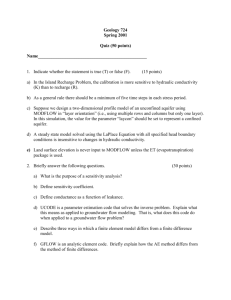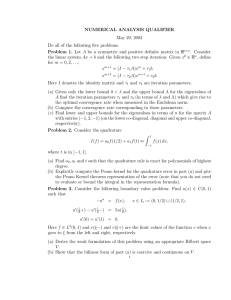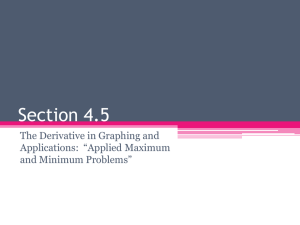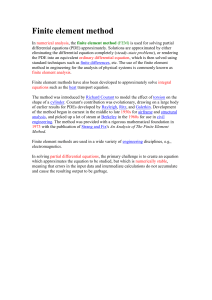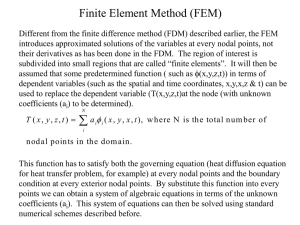e3presen
advertisement
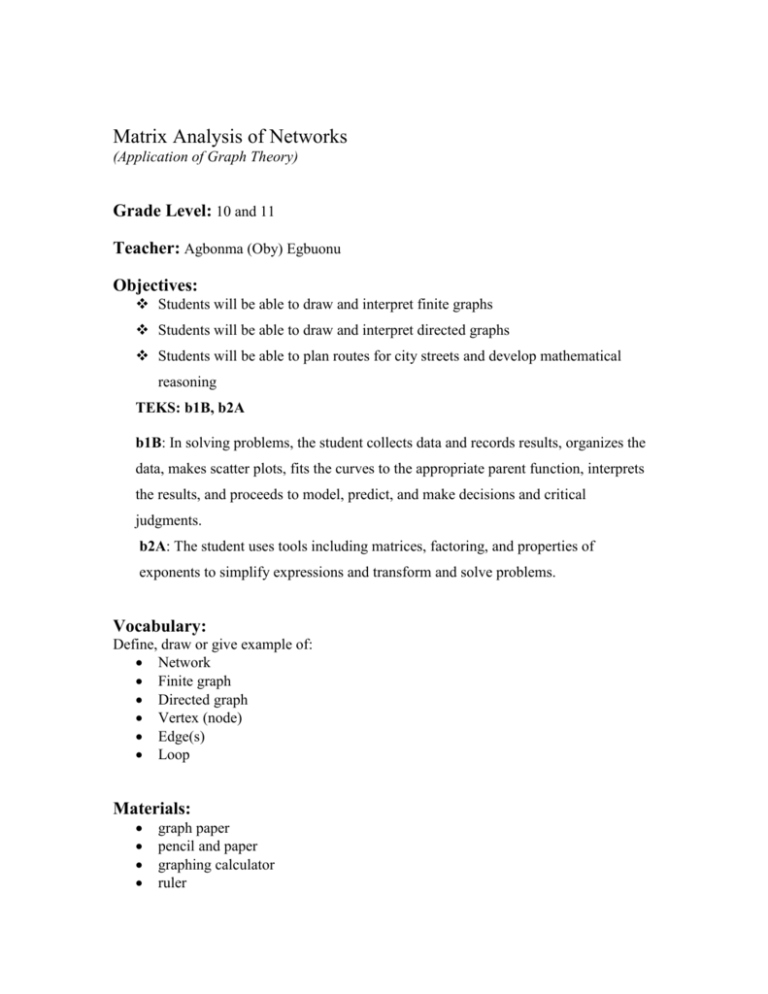
Matrix Analysis of Networks (Application of Graph Theory) Grade Level: 10 and 11 Teacher: Agbonma (Oby) Egbuonu Objectives: Students will be able to draw and interpret finite graphs Students will be able to draw and interpret directed graphs Students will be able to plan routes for city streets and develop mathematical reasoning TEKS: b1B, b2A b1B: In solving problems, the student collects data and records results, organizes the data, makes scatter plots, fits the curves to the appropriate parent function, interprets the results, and proceeds to model, predict, and make decisions and critical judgments. b2A: The student uses tools including matrices, factoring, and properties of exponents to simplify expressions and transform and solve problems. Vocabulary: Define, draw or give example of: Network Finite graph Directed graph Vertex (node) Edge(s) Loop Materials: graph paper pencil and paper graphing calculator ruler Warm-up exercise: Sample problem The Speedy Delivery Company has the delivery area represented by the network shown below: 6 4 C B 5 A 7 3 5 3 D F 5 4 7 E 4 G The numerical weightings are the average driving times in minutes between two pick-up locations. For example, on average it should take a driver 4 minutes to drive from location A to location B. 1. On average how long should it take the driver to travel from A to B to C (path ABC)? Introduction: Cooperative Learning Work with a partner to plan and design a town (a) Make a list of the four most important places or buildings for the town (b) On a sheet of graph paper, draw a simple map of the town. Mark each building and include roads to get from place to place. (c) Make a table that indicates which pairs of locations you can travel between without going through other locations. Monitor students as they work in groups. This activity comes from Advanced Algebra, Prentice Hall. Discuss with students the following definitions: Network Finite graph Vertices (nodes) Directed graph Network A network consists of a set of points, called nodes (vertices), which are connected by segments, called edges (arcs). Edge Node In practical applications, the nodes often represent geographical points like cities, intersections, railroad stops, pipeline connections or individual locations. The edges often represent links between nodes, for example, roads between cities. The arcs can be undirected (two ways) or directed (one way or two ways). A basic problem involving networks is to find the shortest path between two given nodes. Source : HSOR.org:modules-Speedy Delivery Have students brainstorm for a list of networks. Ask students to think about ways in which different kinds of networks are similar and different. Finite Graph Finite graph is a set of points connected by paths. The points are called vertices. A matrix can be used to describe a finite graph. N1 (-6, 2); N2 (-1, 4); N3 (-2,-2) and N4 (4, 2) 5 -1, 4 4 3 -6, 2 4, 2 2 1 0 -8 -6 -4 -2 -1 0 2 4 -2, -2 -3 Using the finite graph above, show students how to present the information from the finite graph in a matrix. Tell students to use a 1 only where there is a direct path between two nodes, and use a 0 to indicate no path between two nodes (vertices). Questions (Finite Graph) (1) What do the zeros along the main diagonal of the matrix represent? (2) What does the zero in position a41 indicate? Explain. (3) State the lengths of N1N2, and N2N3. 6 Directed Graph Directed graph is a finite graph that indicates the direction of a path. You can use a matrix to write directed graph. British Airways route: Houston London New York Using the British Airlines route map, write a matrix A that indicates the routes between these cities. Student practice Exercises: 1. Crystal and Enrique each live near a train station. The train stops near both houses. Vanessa drives a car and has permission to drive to Crystal and Enrique’s houses. Enrique can go by bus to Vanessa’s house but Crystal cannot get to Vanessa’s house by bus. Draw a directed graph indicating the travel options. Then write a matrix to represent the information. 2. Scientists A, B, and C communicate by fax if the have each other’s fax numbers. They communicate by electronic mail if they have each other’s e-mail addresses. Matrix E models the scientists’ possible e-mail matrix, and matrix F models their possible fax matrix. 1 1 0 1 1 1 = E 0 1 1 0 0 0 1 0 1 = F 0 1 0 a) Draw directed graphs for each matrix. b) Analyze the values along the main diagonals of E and F. c) Calculate E + F. What does the matrix model? Explain. 3. Alice and Becky live on the River Drive East, at the intersections of Memorial Bridge and Benjamin Bridge, respectively. Carl and David live on River Drive West, at the intersections of Benjamin Bridge and Memorial Bridge, respectively. River Drive East is a one-way street running east. River Drive West is one-way running west. Both bridges are two-way. Draw a directed graph indicating road travel between the houses. Then write a matrix to represent the information. Assessment: Class participation Completed assignments Teamwork Closure: Writing: Compare and contrast a finite graph and a directed graph. Remind students that compare means how they are alike, and contrast means how they are different. Resources: Advanced Algebra, Prentice Hall Discovering Geometry, An Investigative Approach, Key Curriculum Press HSOR.org: Modules (High School Operation Research)

